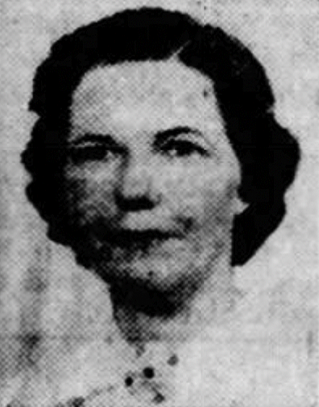
Callie Eliza Pridgen Williams of Stedman, Cumberland County, was appointed to the board in 1951 by Gov. W. Kerr Scott (1896–1958). She succeeded State Senator Hugh G. Horton (1896–1959) of Williamston and served until the end of her term on June 30, 1957. Gov. Luther Hodges (1898–1974) then appointed J. Herbert Waldrop, executive vice president of Guaranty Bank and Trust Company in Greenville and one of East Carolina’s first alums, to succeed her. Waldrop had, incidentally, earlier served as a trustee, between 1941 and 1947.
Mrs. Williams, née Callie Eliza Pridgen, was born in South Carolina but moved with her family to Gray’s Creek in Cumberland County. In 1923, she married Bainbridge T. Williams (1891–1961), a native of Stedman, also in Cumberland County, not far from Fayetteville. Mr. Williams was a postal clerk and rural mail carrier, and Mrs. Williams taught music at the county high school.
Throughout her professional life, Mrs. Williams was active in civic-minded, educationally oriented initiatives. She participated in the Home Demonstration Movement seeking to improve the lives of rural women, sponsored by the U. S. Department of Agriculture’s Cooperative Extension Service. With an emphasis on civics as well as home economics, the movement taught, during Mrs. Williams’ time of service, recently enfranchised women of the countryside economical household skills such as gardening, canning and preserving foods, and sewing. Mrs. Williams assisted in organizing Home Demonstration clubs in eastern North Carolina and served as a delegate at national meetings. In one talk she gave in Duplin County, she emphasized that “individuals need to exercise their privileges in making the world free and safe from wars.”
Mrs. Williams was also active in the North Carolina Congress of Parents and Teachers at the district, state, and national levels, assuming various leadership positions in that organization. However, both the PTA and the Home Demonstration Movement operated, throughout the 1950s, along segregated, Jim Crow lines. During Mrs. Williams’ tenure as a trustee, East Carolina also remained a segregated campus even as it faced successive challenges to the status quo before and after the 1954 Supreme Court Brown v. Board of Education decision declaring segregation unconstitutional. Despite that ruling, East Carolina continued to resist racial openness until the North Carolina state legislature amended the charter for state-supported colleges, removing language designating them in racially specific terms. Thereafter East Carolina’s board expressed regret over the change but slowly began to comply by allowing — during Mrs. Williams’ tenure — for interracial meetings on campus.
Mrs. Williams did not vary with the board during her years of service, revealing that her well-documented dedication to social improvement notwithstanding, she had yet to transcend Jim Crow biases. Just over a decade after her appointment and several years beyond her time on the board, East Carolina at last began to desegregate by admitting the school’s first African American undergraduate, Laura Marie Leary (1945–2013).
Sources
- Anderson, Jean. “Just Being Together Best Part of Convention Trip to Boston for Home Demonstration Women.” News and Observer. September 16, 1953. P. 10.
- “Annual Meeting of Eighth District P.T.A. To Be in Wilmington Oct. 11.” Wallace Enterprise (Wallace, N.C.). October 3, 1949. Pp. 1, 6. https://newspapers.digitalnc.org/lccn/sn94058243/1949-10-03/ed-1/seq-6/#words=B+Mrs+T+Williams
- “Citizenship is Theme of District Council.” Duplin Times (Warsaw, N. C.). April 10, 1952. P. 1. https://newspapers.digitalnc.org/lccn/sn92074110/1952-04-10/ed-1/seq-1/#words=Citizenship+Theme
- “District P.-T.A. Session Slated.” Wilmington Morning Star. October 10, 1945. P. 4. https://newspapers.digitalnc.org/lccn/sn78002169/1945-10-10/ed-1/seq-4/#words=B+Mrs+T+Williams
- “East Carolina College Board of Trustees minutes, April 11, 1956.” University Archives # UA01.01.01.01.04. J. Y. Joyner Library. East Carolina University. Greenville, N. C. https://digital.lib.ecu.edu/10261
- “East Carolina College Board of Trustees minutes, August 9, 1957.” University Archives # UA01.01.01.01.04. J. Y. Joyner Library. East Carolina University. Greenville, N. C. https://digital.lib.ecu.edu/10260
- “East Carolina College Board of Trustees minutes, May 17, 1952.” University Archives # UA01.01.01.01.04. J. Y. Joyner Library. East Carolina University. Greenville, N. C. https://digital.lib.ecu.edu/10264
- “East Carolina College Board of Trustees minutes, May 18, 1957.” University Archives # UA01.01.01.01.04. J. Y. Joyner Library. East Carolina University. Greenville, N. C. https://digital.lib.ecu.edu/10265
- “East Carolina College Board of Trustees Minutes, May 22, 1954.” University Archives # UA01.01.01.01.04. J. Y. Joyner Library. East Carolina University. Greenville, N. C.
- https://digital.lib.ecu.edu/10268
- “East Carolina College Board of Trustees minutes, November 20, 1951.” University Archives # UA01.01.01.01.04. J. Y. Joyner Library. East Carolina University. Greenville, N. C. https://digital.lib.ecu.edu/10266
- “ECC Trustee Takes Office.” News and Observer. July 7, 1957. P. 6.
- “ECC Trustees Named by Gov. Scott.” News and Observer. July 14, 1951. P. 16.
- “Group Conferences to Feature P.-T. A. Institute Program at UNC.” Wilmington Morning Star. July 31, 1941. P. 8.
- “Have Prominent Roles in P.-T.A. Institute.” News and Observer. August 5, 1941. P. 12.
- “Home Demonstration Organization and Planning for Duplin County.” Duplin Times (Warsaw, N. C.). February 18, 1954. P. 3. https://newspapers.digitalnc.org/lccn/sn92074110/1954-02-18/ed-1/seq-3/
- “National PTA: History.” https://www.pta.org/home/About-National-Parent-Teacher-Association/Mission-Values/National-PTA-History
- “P.-T.A. Congress President Names New Chairmen.” Wilmington Morning Star. April 25, 1943. P. 9. https://newspapers.digitalnc.org/lccn/sn78002169/1943-04-25/ed-1/seq-9/#words=B+Mrs+T+Williams
- “P.-T. A. Meets Are Scheduled in 10 Districts.” Wilmington Morning Star. September 5, 1944. P. 5. https://newspapers.digitalnc.org/lccn/sn78002169/1944-09-05/ed-1/seq-5/#words=B+Mrs+T+Williams
- Records of the Chancellor: Records of John Decatur Messick, 1947-1959. University Archives # UA02-05. “Box 7: Williams, Mrs. B. T., Member of the Board of Trustees, 1951-1954.” J. Y. Joyner Library. East Carolina University. Greenville, N. C. https://digital.lib.ecu.edu/special/ead/findingaids/UA02-05
- The Home Demonstration Agent. U. S. Department of Agriculture. AIB 38 – July 1951. https://naldc.nal.usda.gov/download/CAT87791369/pdf
Citation Information
Author: John A. Tucker, PhD
Date of Publication: 03/22/2023